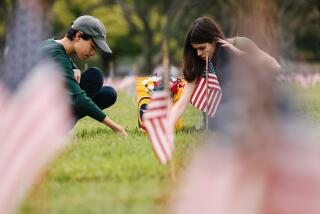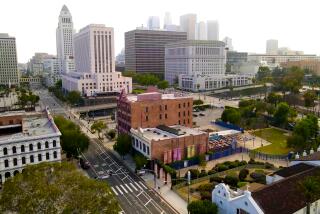A Dying Tradition : Old Mission Cemetery Nearly Full After 200 Years as LocalsŌĆÖ Last Stop
SAN JUAN CAPISTRANO ŌĆö As they have for two centuries, the mourners inched along Ortega Highway, oblivious to the 20th-Century traffic jam around them.
The men leading the procession on a recent Saturday marched slowly, carrying crosses and candles. Behind them were family, friends, townsfolk and a hearse carrying the casket of a longtime San Juan Capistrano resident.
As motorcycle officers blocked intersections leading to the busy San Diego Freeway, the head priest from Mission San Juan Capistrano filed by, chanting Hail Marys and other prayers.
For a moment on that hot, fall morning it was as if time had stood still. Cars and pedestrians stopped in their tracks to watch a ritual that is almost as old as the historic community.
The march ended at the Old Mission Cemetery, the final stop for San Juan Capistrano residents for the past 200 years, where today the quiet calm around the grave site is punctuated by the sound of trucks and cars speeding by on the freeway.
The 2-acre, tree-lined hilltop is a great equalizer. Unmarked graves lie not far from other plots bearing old wooden crosses over the resting places of Indians, settlers and other early residents.
Elsewhere in the cemetery are headstones and grave markers that spell out the history and heritage of San Juan, an area that has grown from a mission town to a thriving modern city.
Markers bearing such names as Yorba, Forster, Doram, Luna, Avila, Rios and Manriquez are silent reminders of the American Indians of the area who lived, worked and died building the town.
There are countless stories etched into the tombstones of children, many of whom died at birth or at an early age. Three Civil War veterans lie at rest just a few rows away from the graves of Indians and nobility.
According to Mission San Juan Capistrano Church archivist Charles Bodnar, the land was deeded by a Scottish settler named James Sheehan in 1879 to the Catholic Church for the sum of $100.
Records also show that many Indians and settlers had been buried there since the late 1700s, a century before the land was deeded. Before that, the priests and Indians were buried at the mission, down the road.
Bodnar has more than a casual interest in the old cemetery on the hill. A few years ago, he and an associate rescued the cemetery from the thick brush and weeds that were threatening to take over the place. He also repositioned and painted the little white crosses that now stand in perfect rows near the entrance.
These days the cemetery is maintained by a full-time caretaker who is employed by the San Juan Capistrano Mission Catholic Church to carefully rake and weed the hilltop site.
Dennis Sommers, 37, himself an American Indian and a native of San Juan Capistrano, was given the task of keeping the old graveyard clean. He also must hold off the ravages of weather and time that threaten to erode even more names from the headstones.
Sommers, who has several family members buried there, remembers a time when San Juan Capistrano was so small that everyone knew each other. And so he recognizes the names on many gravestones, and sometimes he stops to quietly talk to his one-time friends while he drags the rake over the old soil.
ŌĆ£Not to sound like a nut, but yeah, I do talk to the graves. Sometimes I talk to my brother. I talk to him and tell him that IŌĆÖm sorry for the way things worked out.ŌĆØ
Before the city became so large, most of the townsfolk were buried there, and the old cemetery remains the sentimental favorite among locals. But now, because of the South County population boom, most are buried in El Toro.
Space at the Old Mission Cemetery is at a premium. There will only be a few more of the long processions winding up the Ortega Highway.
More to Read
Sign up for Essential California
The most important California stories and recommendations in your inbox every morning.
You may occasionally receive promotional content from the Los Angeles Times.










